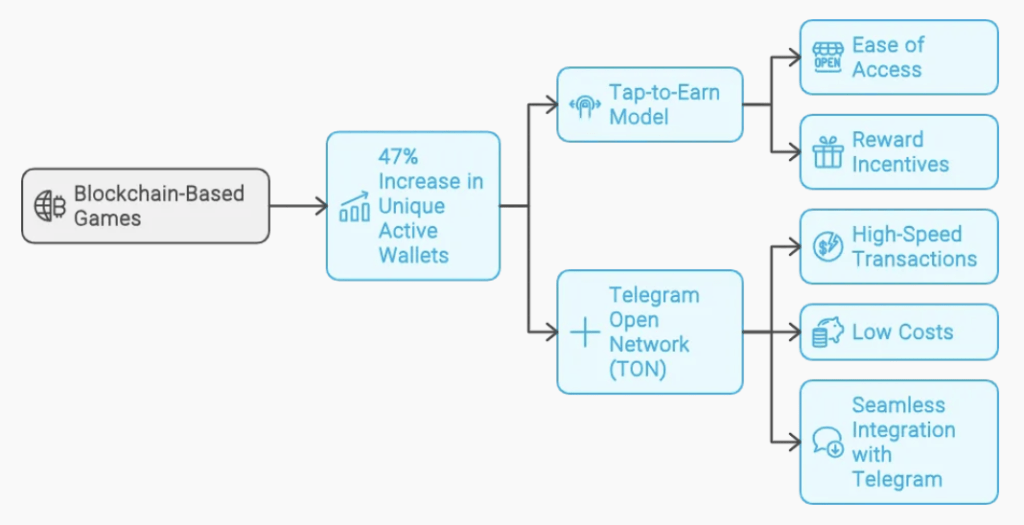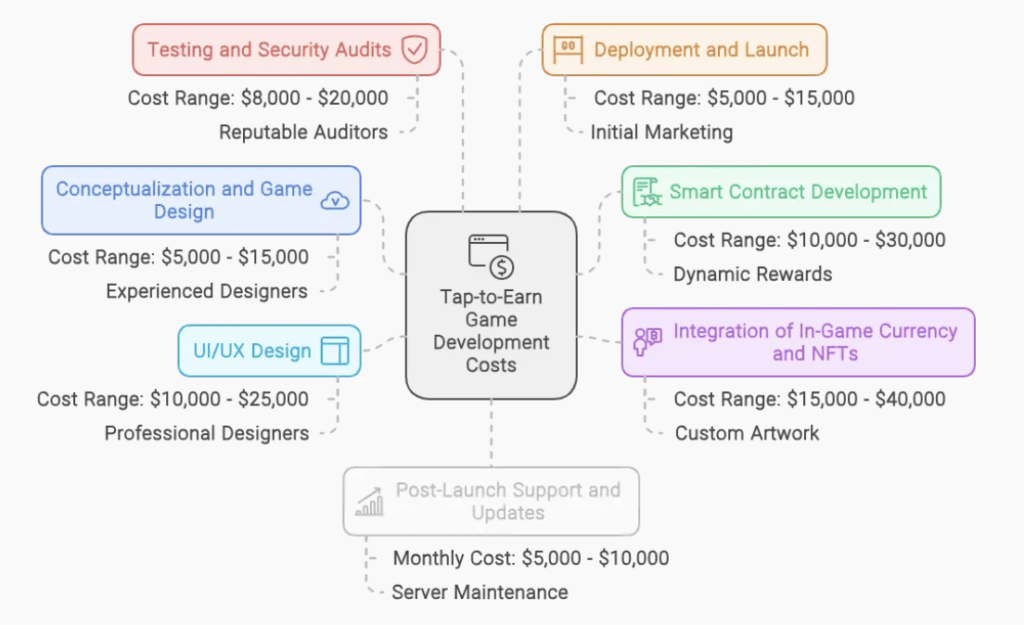As of 2023, the P2E market has an approximate volume of $4.6 billion, and shows annual growth at a compound annual growth rate (CAGR) of 14.5 per cent from 2024 to 2030.Tap-to-earn is growing in popularity, and TON’s features and capabilities offer an entirely new competitive landscape for gaming developers who see a lucrative opportunity in this expanding market.
This article describes the evolution of tap-to-earn games on the TON blockchain. It explains the benefits of TON for developers, the process of f developing the game and an estimate of the cost of the main features of the platform. The article will be of interest to gaming developers who want to create their next game, and to investors who want to understand the potential of tap-to-earn models in TON.
Why Choose the TON Blockchain for Tap-to-Earn Games?

1. High-Speed Transactions:
Its ability to process millions of transactions per second (TPS) means it is ideally suited to games where everything must happen in real-time. ‘You don’t want to be waiting a minute to get rewarded. You don’t want to have to wait three minutes to buy something in your game, because you’ll just change your mind,’ he says. Other popular blockchains, such as Ethereum – with a mere 15 to 30 TPS – could struggle to cope with the demands of a tap-to-earn game.
2. Low Transaction Costs:
Transaction fees can be an issue for all blockchain-based games, but especially those with a lot of microtransactions. TON addresses this with very low transaction fees, which means developers can afford to include tap-to-earn mechanics without gouging players. On TON, transaction fees are usually in the range of fractions of a cent, while on Ethereum transaction fees can be somewhere around $10 or even as much as $100 during periods of network congestion.
3. Seamless Integration with Telegram:
For TON, one of its main selling points is that devs can market their tap-to-earn games to the more than 700 million active users of the Telegram messaging app – itself running on TON. It’s also a no-brainer for users of the Telegram app, as they can use the in-built wallet for in-game transactions and have a direct line of communication with the community and players.
4. Decentralized and Transparent:
The fact that everything in TON is decentralised – all game data, transactions and rewards – gives greater confidence to all participants in the game. Players know that everything is visible and immutable. Finally (and most important for gamers), TON decentralised governance enables the gaming community itself to have a say in the development and evolution of the gaming platform.
5. Developer-Friendly Ecosystem:
There are SDKs and APIs provided by TON, as well as templates for smart contracts that can help developers create tap-to-earn games. All the frameworks and tools are there so developers don’t need to build things from scratch, and a big developer community, along with tons of documentation, is available to help troubleshoot and optimise.
The Development Process for Tap-to-Earn Games on TON
1. Conceptualization and Game Design:
The first is to design the gameplay. Because tap-to-earn games are all about simplicity and often make use of mechanically Loopy experiences, this means designing an addictive and rewarding trial-and-error process. The gameplay mechanics will typically consist of a tapping action that players perform to earn rewards, defeat enemies or complete objectives. A tap-to-earn designer might think of ways to put token rewards on the line and to distinguish achievements with NFTs.
2. Smart Contract Development:
Smart contracts are the foundational component of any blockchain-based game. TON’s tap-to-earn games will use smart contracts to manage in-game assets and rewards, dictate conditions for players to receive rewards, and manage transactions. Developers will have to code different smart contracts that can execute different types of functions: for example, to mint tokens, to award gameplay-based rewards, and to ensure that transactions happen safely. TON’s smart contract language, FunC, is tailored for speed and efficiency, making it well-suited for the rapid interactions required in tap-to-earn games.
3. Integration of In-Game Currency and NFTs:
The promise of real-world value earned through play is one of the big draws of tap-to-earn games. Tap-to-earn games allow developers to create an in-game currency or NFTs (Non-Fungible Tokens) based on native tokens on the TON blockchain. Players can earn, trade or spend the token in the game, and NFTs can function as unique, tradeable assets, such as skins, characters or in-game items. Those NFTs can be sold on a marketplace or traded for in-game assets.
4. User Interface and Experience (UI/UX) Design:
One of the most important aspects of tap-to-earn games is their ease of use, or ease of play. The same goes for the user experience (UX), which has to clearly and readily communicate to the player what they can do and how they can do it to make money in the game. This means having a simple and intuitive user interface that makes it easy for new players of all skill levels to enjoy the game with minimum barriers and without a steep learning curve. In terms of gameplay, UX should also create smooth interactions (ie, no bugs and glitches), quick feedback cycles and a rewarding experience that keeps the player engaged and coming back to the game. Another advantage is that players can set up a Telegram interface that allows them to interact with the game without having to leave the messaging app.
5. Testing and Security Audits:
It should then be rigorously tested before going live to confirm that the gameplay is sound, that the smart contracts are functioning correctly, and that there is no way to exploit vulnerabilities in the system either accidentally or maliciously. Since these games involve real money, security is obviously of the utmost importance. Security audits of the smart contracts and game code should be taken very seriously, and may include hiring third-party auditors to provide feedback on the code and to identify any remaining vulnerabilities.
6. Deployment and Launch:
When the game is fully developed and tested, the next step is to deploy it to TON’s blockchain. This includes deploying relevant smart contracts, setting up the in-game economy (exchanging coins and buying items), making it available to players, and marketing it within the Telegram community and beyond. One of the biggest advantages of TON is its deep integration with Telegram, which means that developers can easily reach a large audience immediately after the launch. This can be done using channels, groups and bots.
7. Post-Launch Support and Updates:
However, work on the game doesn’t stop when the game is launched. Regular updates and support are needed to keep the game interesting. Players’ feedback should be taken into account, and bugs should be dealt with. New events or features could be added regularly. Most importantly, the in-game economy must be monitored to ensure that the tap-to-earn model is sustainable and fair to all players.
Cost Analysis of Tap-to-Earn Game Development on TON
There are several different costs associated with the development of a tap-to-earn game on the TON blockchain that can differ depending on the complexity and scale of the game to be developed, the necessary technical requirements to implement a certain type of game, the size and experience of the development team, and other criteria.

Below is a breakdown of the typical costs associated with each stage of development:
1. Conceptualization and Game Design:
This stage may cost between $5,000 and $15,000, depending on how detailed the game-design process needs to be and how complex the rules or mechanics are. If experienced game designers and blockchain consultants are hired, costs can escalate very quickly. Most important of all is that the game has to be fun.
2. Smart Contract Development:
The cost of developing smart contracts for a tap-to-earn game on TON ranges between $10,000 and $30,000. This price includes not only coding the smart contracts that are responsible for handling game in-app purchases, rewards and NFT management, but also testing and deployment. If there is no need for smart contracts to be complex or dynamic (for example, when plannig a simple ‘farming’ game that rewards only for taps), the cost of development decreases. However, if you are looking for dynamic rewards or other smart-contract-enabled features, like integrating with external systems, expect the cost to go up.
3. Integration of In-Game Currency and NFTs:
Adding your own native token to the game as well as supporting NFTs would add an additional $15,000 to $40,000 to the budget. That would cover the cost of the token, setting up the in-game economy, and the initial NFT integration costs. If the game also requires custom art or unique NFTs (like a new monster or the face of your character), it’ll cost more, especially if you have to hire a designer or artist.
4. UI/UX Design:
At this point, the interface needs to be clear, attractive and easy to use – ideally difficult to distinguish from something built by a professional game developer. Depending on the complexity of the game and the level of professional design required, this stage can cost between $10,000 and $25,000. In cases where the game is integrated into a third-party platform such as Telegram, developers must employ designers who are experienced in creating interfaces that will appeal to a wide audience.
5. Testing and Security Audits:
Security is a crucial aspect of blockchain games, so a testing and audit phase, which typically takes up to a month, comes next. This can cost between $8,000 and $20,000 depending on the extent of the testing and the security auditors. The audits of smart contracts performed by reputable firms help to ensure that the game is free from exploitable flaws and vulnerabilities such as the notorious DAO (distributed autonomous organisation) hack in 2016.
6. Deployment and Launch:
Developing a TON-based game will involve some costs for hosting and infrastructure, at least initially, as well as your own marketing efforts, which is bound to cost at least a few thousand dollars – between $5,000 and $15,000 altogether. You will likely need to invest some money in marketing, especially to Telegram users, in order to bring new players to your game.
7. Post-Launch Support and Updates:
It needs constant upkeep and updates to retain players and keep the game ahead of the competition. Typically this can be anywhere from $5,000 per month on the lower end to $10,000 on the higher end. This includes the regular costs of server maintenance, updates, bug fixes and content pushes. Game developers should always budget these costs over the long run in order to keep the game alive for its players.
Total Cost Estimation
With all the factors considered, the price to develop the tap-to-earn game for TON blockchain from a concept phase to post-launch support is estimated at $2o,000-$100,000. The exact costs depend on the specifics of the game and its requirements, as well as the proficiency of the development team and the additional features and customisation that may be needed.
Conclusion
Tap-to-earn game development on the TON blockchain is one of the biggest chances in the booming crypto gaming market. TON has a higher speed of transactions, lower costs, and dynamic Telegram infrastructure. This can be a perfect gaming intermediary for developers to build interesting, entertaining, useful and most importantly profitable games. TON has the ability to test and launch successful tap-to-earn games with a big audience and a huge potential for growth.
FAQs
1. What is a tap-to-earn game?
Tap-to-earn games are a class of blockchain-based play-to-earn games that reward users, typically in cryptocurrency or NFTs, for completing tasks or defeating enemies by tapping a screen. They are designed to be simple and fun to play, and to enable earners to obtain digital assets with the minimum level of engagement.
2. Why is the TON blockchain suitable for tap-to-earn games?
The TON blockchain is a perfect fit for such games: not only does it feature high speed, low fees and decentralised hosting, it can be integrated via Telegram, allowing instant gameplay, microtransactions at a fraction of the cost, and a built-in user base numbering in the tens of millions – win-win for devs and players alike.
3. What is the starting cost to release a game where you tap to earn on the TON blockchain?
It costs between $58,000 and $155,000 to develop a tap-to-earn game on a blockchain like TON. The costs go towards game design, smart contract development, NFT integration, UI/UX design, testing, deployment and live support.
4. What are the key features of a tap-to-earn game on TON?
Other defining features include the ability to carry out fast, secure transactions, combined with integration for a native in-game currency and NFTs, as well as tools for a user-friendly interface. Together with the possibility of Telegram integration, developers have a variety of opportunities for fostering communities and direct communication with players.
5. How can developers monetize a tap-to-earn game on TON?
Developers can monetise their tap-to-earn games through in-game purchases, in-app ads and by selling NFTs. They can also take a cut of each transaction fee when players trade or spend their earnings in-app.
6. What security measures are necessary for tap-to-earn games?
Security is very important in blockchain games. It’s important for every developer out there to test and do security audits on their smart contracts so they can become more hack-proof and constantly updated. Smart contracts should also be updated and maintained following a launch, in case any new vulnerabilities are found.
7. How can developers market their tap-to-earn games on TON?
Developers can gain exposure by promoting games in Telegram channels and groups, and with bots, as well as in other crypto communities: advertising, running campaigns and nurturing influencers can also help to bring in players.
8. What challenges might developers face when building on TON?
Developers are likely to grapple with keeping up with changes in the TON ecosystem, working in sync with Telegram, and being able to secure their work in a decentralised setting. TON’s developer resources, being an open source blockchain according to its white paper, as well as a community of developers and interested users, should aid in mitigating these challenges.
- Why Choose the TON Blockchain for Tap-to-Earn Games?
- The Development Process for Tap-to-Earn Games on TON
- Cost Analysis of Tap-to-Earn Game Development on TON
- Total Cost Estimation
- Conclusion
- FAQs
- 1. What is a tap-to-earn game?
- 2. Why is the TON blockchain suitable for tap-to-earn games?
- 3. What is the starting cost to release a game where you tap to earn on the TON blockchain?
- 4. What are the key features of a tap-to-earn game on TON?
- 5. How can developers monetize a tap-to-earn game on TON?
- 6. What security measures are necessary for tap-to-earn games?
- 7. How can developers market their tap-to-earn games on TON?
- 8. What challenges might developers face when building on TON?
Explore more topics
Talk to Our Expert
